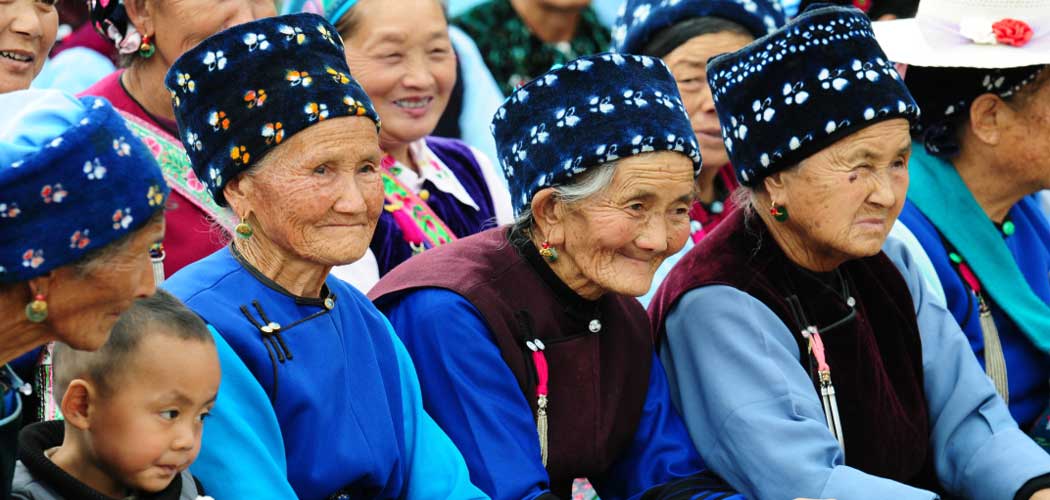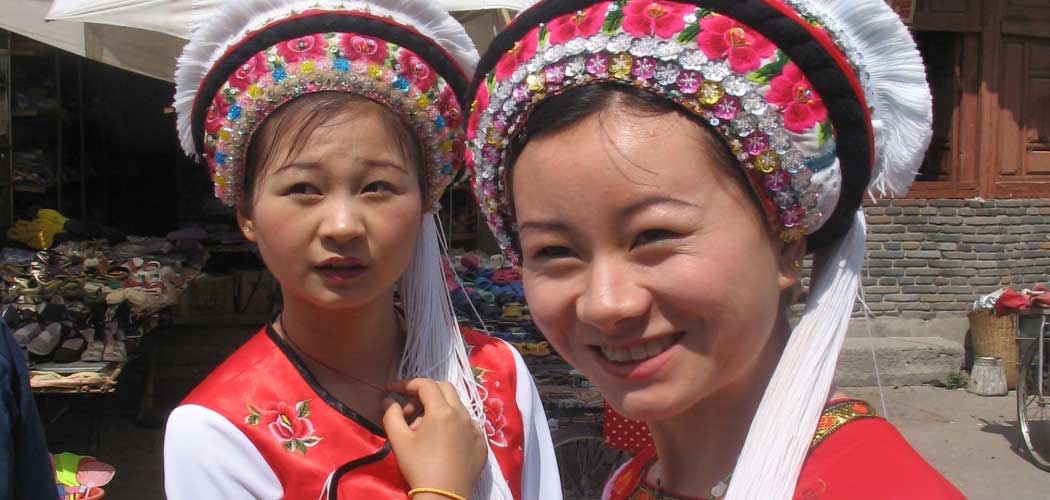The Bai minority of Dali
There are 1.9 million of Bai minority people living in Yunnan, mainly of them settle in Dali Baizu autonomous prefecture. Bai people widely spread over Yunnan, Guizhou and Sichuan province, more than 90% of the population engaged in the farming production, especially the paddy rice planting. Bai minority has its own language, however the Chinese language are in common use among most of the Bai people.
Population and geographic distribution
The Dali region, which has remained inaccessible to foreigners since 1983, is the main location for the Bai minority, numbering 1,900,000.
Language and writing
Their language belongs to the Sino-Tibetan family, Tibeto-Burman branch. The Bai use the Chinese characters they use to transcribe their own language.
History
The Bai community is formed around the 7th – 8th centuries, at the time of the kingdoms of Nanzhao and Dali. It is made up of all the populations that then occupy the Erhai Lake region, that is to say natives, Han migrants, Tibetan Di and Qiang, Burmese and Yi whose culture and language have undergone reciprocal influences, merging locally to form the Bai culture. In 1958, during the Cultural Revolution, a large part of Bai fled to Burma.
Religion
The Bai religion mixes Taoism and local animism, spirits of ancestors and spirits associated with natural elements. The main deity is Benzhu, likened to the God of the soil or place. In each Bai village, it is common to find an altar of the god of the soil, Benzhu, which protects the village. In Shibaoshan, a rock shaped female, called Ayangbai, is revered by local people. This cult originates from the archaic local cults of fertility and fertility.
Feasts and festivals Bai in Dali
There are lots of traditional festivals happen within the Bai minority. “March Fair” is the biggest event in the year, which has more than 1000 years of history. The “Torch Festival” is another famous activity for Bai minority; it is also celebrated by some other minorities like Yi, Naxi and so on.
-
Ascent of Jizi Mountain (1-15th day of the 1st lunar month)
During these two weeks, the Bai climb to the top of the mountain of rooster legs (Jizi Mountain) to pray to the gods in the temples and make their vows for the new year. By the thousands, they pray, make offerings of food and wine, sing and dance. At the different temples of the mountain, the locals make their resolution for the coming year, or thank the gods for the success of their requests last year.
-
The Taizi festival in Jianchuan (8th day of the 2nd lunar month)
The Taizi festival is held every year during the 8th day of the second month of the lunar calendar. Taizi locally designates the “Sakyamuni Buddha”. This one, prince of a kingdom in India was destined to be the king at the adulthood. After leaving home, he saw the suffering of the world, and wanted to help the poor. He left everything to find a way to reach an ideal life, which later became the practice of every Buddhist. The festival of Taizi reproduces this event, when the prince left the royal palace, then created the religion of Buddhism. During the festival, locals clean Buddha statues in local temples in Jianchuan, then carry statues in processions through village streets, followed by various songs and dances.
-
The March Fair (15-21st day of the 3rd lunar month)
The “Third Month Fair” is the largest Bai minority festival in the Dali region. Originally, this festival was called “The Avalokitesvara Festival”, named after the legendary hero Avalokitesvara who released Dali from the Luocha monster and allowed the people to prosper. Every year, the Bais gather at the Chongshengsi Temple to pay homage and express their gratitude to Avalokitesvara. Over the years, this festival has become an opportunity for trade in goods, and it is now a great annual fair. It is also an opportunity for entertainment, with horse racing, street opera, and traditional songs and dances.
-
Feast of the fertility “Raosanling” (23rd day of the 4th month)
During this day, the locals hike to the sacred Jizu Mountain, pray to their ancestors and dance.
-
The Torch Festival (25th day of the 6th lunar month)
That day, each village prepares a big torch. In the evening, the big and small torches are lit and people go around the fields in single file to chase the woes.

Marriage customs
The marriage is based on monogamy, with the prohibition to marry in the same clan or with someone with the same surname. It is not bad to marry someone from another ethnic group.
Intermarry is forbidden among the Bai minority, not even the same ancestry and spouse with the same surname. Dissimilar than the majority Han people, sons in the Bai family live separately to their parents. Bai people are particular about tea. They like to welcome the guests by serving the famous Bai special drink – the Three Courses Tea. These three cups of tea present the meaning of life just like the taste of the tea: bitter first, then come with the sweetness and finally the third one gives you the aftertaste. There is a folk saying “Filling full glass of wine shows respects while full glass of tea has the meaning of swindle.”, which is the reason why Bai people never serve you a full glass of tea.
Clothing
In Dali, Bai women wear a white and pink top with blue patterns on the sleeves. The Bai women’s headdress has 3 characteristics: “wind, flowers, snow”. Men wear white clothing with a black or blue vest, on long blue or black pants.
Either boys or girls, Bai minority people are just greatly admire the white color, to express the elegance and the image of pure. In Yunnan Eryuan County, men who are in the mature age always carry an lover-made exquisite pouch, embroidered with the patterns of birds and ducks that represent the symbol of love. Dressing style for girls is always different in various areas. In Dali, white or light blue blouse will be matched with the red sleeveless jacket, embroidered waistcloth and shoes. Adolescent girls wore their hair braided in a single long pigtail, then coiled it at the top of the head with cerise strings and white headscarf. Married women usually make a coiffure with a topknot or coil up with the hairpins. Bai minority people in Dali regard flowers as beauty. We can see from their clothing often ornamented with the Camellias. Bai women also like to wear earrings and bracelets.
The marble of Dali
The region of Dali is famous throughout China for its marble whose polishing reveals veins whose shapes are reminiscent of waterfalls, mountain peaks or clouds of traditional Chinese paintings. The marbles of Dali, called “dream stones” decorate the living room furniture and are even hanging on the walls of the great aristocratic houses as the most beautiful of the artistic works, the one that draws the nature itself.
